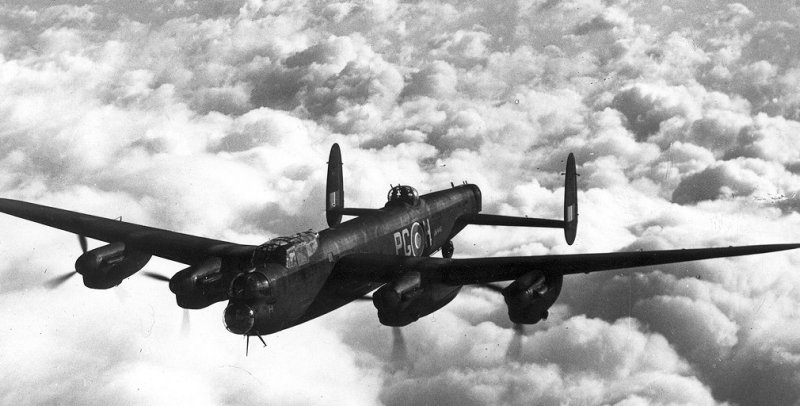ACUFO-1944-02-03-GERMANY-1
In their 2003 book, Nick Redfern et Andy Roberts, and in the 2010's, the ufology Website Saturday Night UFOria indicated that an incident appeared for February 3, 1944, in records for the period at Britain's National Archives categorized as "Enemy defences: phenomena", for the period from September 1942 thru February 1944.
It involved a Lancaster bomber, and said:
"It was a ball of red fire on port side 2 miles away at same height with yellowish red flame coming out behind and black smoke. It was 30/40 m.p.h. faster than the Lancaster. It went like this for a period of 3/4 to 1 minute. It did not explode at any time. Fizzled out and not seen again. The smoke was very black and showed up well against grayish night background. It followed when Lancaster went into a dive and again on corkscrewing. It seemed to go out once but sprang into life again when Lancaster changed from dive to starboard into a corkscrew."
| Date: | February 3, 1944 |
|---|---|
| Time: | Probable night. |
| Duration: | 40 seconds to 1 minute. |
| First known report date: | February 1944 |
| Reporting delay: | Hours, weeks. |
| Country: | Germany |
|---|---|
| State/Department: | |
| City or place: |
| Number of alleged witnesses: | ? |
|---|---|
| Number of known witnesses: | ? |
| Number of named witnesses: | 0 |
| Reporting channel: | Military summary report. |
|---|---|
| Visibility conditions: | Night. |
| UFO observed: | Yes. |
| UFO arrival observed: | ? |
| UFO departure observed: | ? |
| UFO action: | Follows, turns off, reappears. |
| Witnesses action: | Evasive maneuvers. |
| Photographs: | No. |
| Sketch(s) by witness(es): | No. |
| Sketch(es) approved by witness(es): | No. |
| Witness(es) feelings: | ? |
| Witnesses interpretation: | ? |
| Sensors: |
[X] Visual: 1 or more.
[ ] Airborne radar: [ ] Directional ground radar: [ ] Height finder ground radar: [ ] Photo: [ ] Film/video: [ ] EM Effects: [ ] Failures: [ ] Damages: |
|---|---|
| Hynek: | NL |
| Armed / unarmed: | Armes, 8 7.62 mm machine guns. |
| Reliability 1-3: | 2 |
| Strangeness 1-3: | 2 |
| ACUFO: | Unidentified. |
[Ref. nrr1:] NICK REDFERN AND ANDY ROBERTS:
The authors say that this report surfaced on February 3, 1944:
It was a ball of red fire on port side 2 miles away at same height with yellowish red flame coming out behind and black smoke. It was 30/40 m.p.h. faster than the Lancaster. It went like this for a period of 3/4 to 1 minute. It did not explode at any time. Fizzled out and not seen again. The smoke was very black and showed up well against grayish night background. It followed when Lancaster went into a dive and again on corkscrewing. It seemed to go out once but sprang into life again when Lancaster changed from dive to starboard into a corkscrew.
[Ref. snu1:] "SATURDAY NIGHT UFORIA" WEBSITE:
This website indicates that an incident appeared for February 3, 1944 in records for the period at Britain's National Archives categorized as Enemy defences: phenomena, for the period from September 1942 thru February 1944, an incident involving a Lancaster bomber which had a rated top speed of 280 m.p.h.
"It was a ball of red fire on port side 2 miles away at same height with yellowish red flame coming out behind and black smoke. It was 30/40 m.p.h. faster than the Lancaster. It went like this for a period of 3/4 to 1 minute. It did not explode at any time. Fizzled out and not seen again. The smoke was very black and showed up well against grayish night background. It followed when Lancaster went into a dive and again on corkscrewing. It seemed to go out once but sprang into life again when Lancaster changed from dive to starboard into a corkscrew."
The Avro 683 Lancaster was a four-engine night bomber built in more than 7,000 units and it became, with the Handley Page Halifax, the main bomber of the Royal Air Force from 1942 on.
Its defense against German fighter planes was 8 7.62 mm machine guns.

|

|
To me, the description evokes a German fighter in flame; but it would have been a bit crazy for its pilot to follow the evasive maneuvers of the Lancaster rather than to save his life with a parachute jump.
This looks like a weird incident, but I have a hard time imagining that the "phenomenon" would have been an extraterrestrial craft; hence I leave it as an "unidentified."
Unidentified.
* = Source is available to me.
? = Source I am told about but could not get so far. Help needed.
| Main author: | Patrick Gross |
|---|---|
| Contributors: | None |
| Reviewers: | None |
| Editor: | Patrick Gross |
| Version: | Create/changed by: | Date: | Description: |
|---|---|---|---|
| 0.1 | Patrick Gross | October 17, 2023 | Creation, [sua1]. |
| 1.0 | Patrick Gross | October 17, 2023 | First published. |
| 1.1 | Patrick Gross | November 16, 2023 | Addition [nrr1]. In the Summary. addition of "In their 2003 book, Nick Redfern et Andy Roberts, and " |